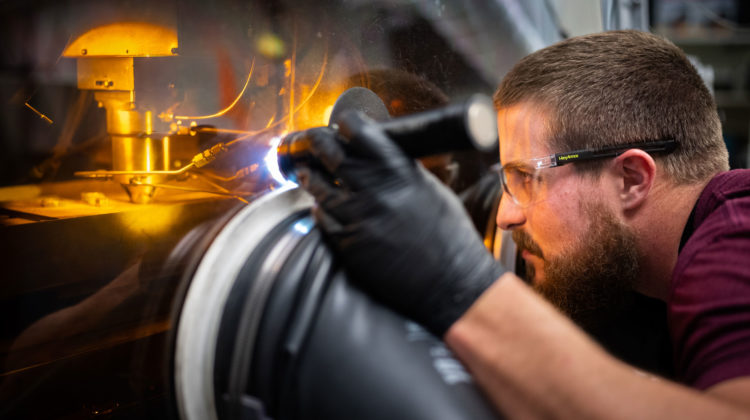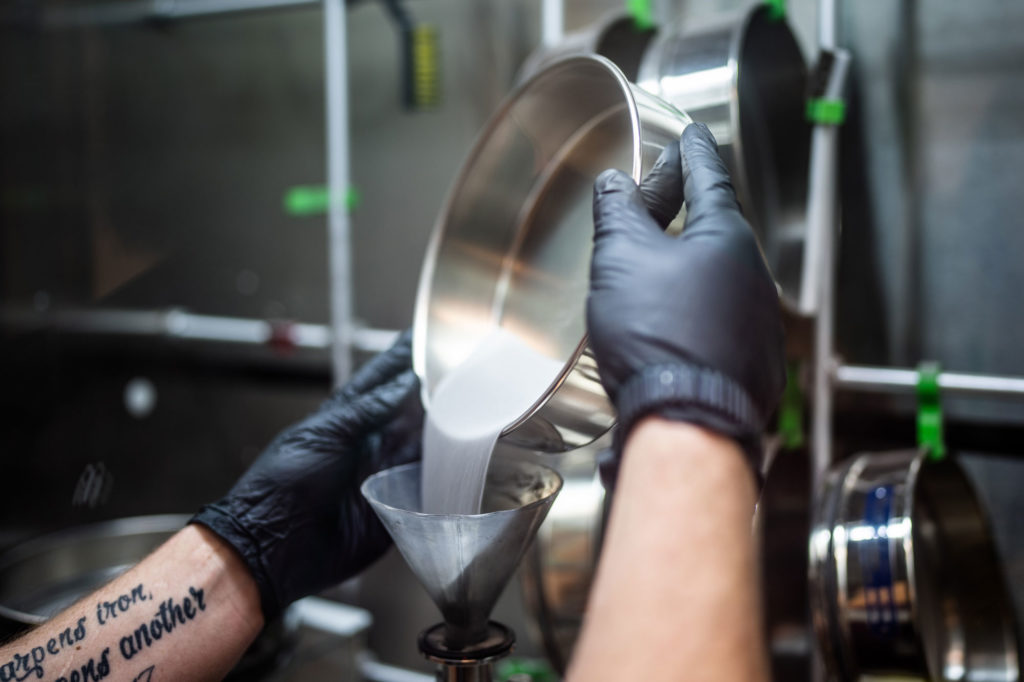
Researchers from the US government’s Sandia National Laboratories in New Mexico have shown that a new 3D-printed superalloy could help power plants generate more electricity while producing less carbon.
Sandia scientists, working together with researchers at Ames National Laboratory, Iowa State University and Bruker Corporation, used a 3D printer to create a high-performance metal alloy, or superalloy, with an unusual composition that makes it stronger and lighter than state-of-the-art materials currently used in gas turbine machinery. The findings could have a broad impact across the energy sector, as well as the aerospace and automotive industries, and hints at a new class of similar alloys waiting to be discovered.
‘We’re showing that this material can access previously unobtainable combinations of high strength, low weight and high-temperature resiliency,’ said Sandia scientist Andrew Kustas. ‘We think part of the reason we achieved this is because of the additive manufacturing approach.’
In the USA, about 80 per cent of electricity comes from fossil fuel or nuclear power plants, according to the US Energy Information Administration. Both types of facilities rely on heat to turn turbines that generate electricity and power plant efficiency is limited by how hot metal turbine parts can get. If turbines can operate at higher temperatures, ‘then more energy can be converted to electricity while reducing the amount of waste heat released to the environment,’ said Sal Rodriguez, a Sandia nuclear engineer who didn’t participate in the research.
Sandia’s experiments showed that the new superalloy – which consists of 42 per cent aluminum, 25 per cent titanium, 13 per cent niobium, eight per cent zirconium, eight per cent molybdenum and four per cent tantalum – was stronger at 800°C than many other high-performance alloys, including those currently used in turbine parts, and still stronger when it was brought back down to room temperature. ‘This is therefore a win-win for more economical energy and for the environment,’ Rodriguez said.

Energy isn’t the only industry that could benefit from the findings. Aerospace researchers seek out lightweight materials that stay strong in high heat. Additionally, Ames Laboratory scientist Nic Argibay said that Ames and Sandia are partnering with industry to explore how alloys such as this could be used in the automotive industry. ‘Electronic structure theory led by Ames Lab was able to provide an understanding of the atomic origins of these useful properties, and we are now in the process of optimising this new class of alloys to address manufacturing and scalability challenges,’ Argibay said.
Additive manufacturing, also called 3D printing, is known as a versatile and energy-efficient manufacturing method. A common printing technique uses a high-power laser to flash-melt a material, usually a plastic or a metal. The printer then deposits that material in layers, building an object as the molten material rapidly cools and solidifies.
This new research demonstrates how the technology can be repurposed as a fast, efficient way to craft new materials. Sandia team members used a 3D printer to quickly melt together powdered metals and then immediately print a sample of it.
Sandia’s creation also represents a fundamental shift in alloy development because no single metal makes up more than half of the material. By comparison, steel is about 98 per cent iron combined with carbon, among other elements.
‘Iron and a pinch of carbon changed the world,’ Kustas said. ‘We have a lot of examples of where we have combined two or three elements to make a useful engineering alloy. Now, we’re starting to go into four or five or beyond within a single material. And that’s when it really starts to get interesting and challenging from materials science and metallurgical perspectives.’
Moving forward, the team is interested in exploring whether advanced computer modelling techniques could help researchers discover more members of what could be a new class of high-performance, additive manufacturing-forward superalloys. ‘These are extremely complex mixtures,’ said Sandia scientist Michael Chandross, an expert in atomic-scale computer modelling who wasn’t directly involved in the study. ‘All these metals interact at the microscopic – even the atomic – level, and it’s those interactions that really determine how strong a metal is, how malleable it is, what its melting point will be and so forth. Our model takes a lot of the guesswork out of metallurgy because it can calculate all that and enable us to predict the performance of a new material before we fabricate it.’
According to Kustas, there are challenges ahead. For one, it could be difficult to produce the new superalloy in large volumes without microscopic cracks, which is a general challenge in additive manufacturing. He also said that the materials that go into the alloy are expensive. So, the alloy might not be appropriate in consumer goods, for which keeping cost down is a primary concern. ‘[However,] with all those caveats, if this is scalable and we can make a bulk part out of this, it’s a game changer,’ Kustas said.
The research has been published in Applied Materials Today.



